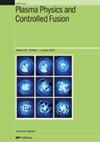Safety factor influence on the edge E × B velocity establishment in tokamak plasmas
IF 2.3
2区 物理与天体物理
Q2 PHYSICS, FLUIDS & PLASMAS
引用次数: 0
Abstract
This study is motivated by experiments on Tore Supra and WEST tokamaks where a deepening of the E × B velocity—governed by the radial electric field Er —near the edge is observed when the safety factor decreases in L-mode plasmas. Flux-driven global simulations of ion temperature gradient turbulence recover qualitatively the trend observed in the experiments, i.e. the E × B velocity increases when decreasing the safety factor. From these simulations, multiple clues point out the role of turbulence in the establishment of the radial electric field even though the turbulent intensity increases with the safety factor. The proposed mechanism to elucidate this phenomenon, backed up by a reduced model, is that the damping of the poloidal flow, governed by the neoclassical friction, increases more strongly with the safety factor than the turbulent drive for Er , due to the (r,θ) component of the Reynolds stress.安全系数对托卡马克等离子体中边缘 E × B 速度建立的影响
这项研究的灵感来自托尔超级托卡马克和西西托卡马克的实验,在这些实验中,当 L 模式等离子体的安全系数降低时,在边缘附近观察到由径向电场 Er 控制的 E × B 速度加深。对离子温度梯度湍流的通量驱动全局模拟定性地恢复了实验中观察到的趋势,即当安全系数降低时,E × B 速度增加。从这些模拟中,有多条线索指出了湍流在建立径向电场中的作用,即使湍流强度随安全系数的增加而增加。在简化模型的支持下,为阐明这一现象而提出的机制是,由于雷诺应力的(r,θ)分量,受新古典摩擦力支配的极环流的阻尼随安全系数的增加比 Er 的湍流驱动更强。
本文章由计算机程序翻译,如有差异,请以英文原文为准。
求助全文
约1分钟内获得全文
求助全文
来源期刊

Plasma Physics and Controlled Fusion
物理-物理:核物理
CiteScore
4.50
自引率
13.60%
发文量
224
审稿时长
4.5 months
期刊介绍:
Plasma Physics and Controlled Fusion covers all aspects of the physics of hot, highly ionised plasmas. This includes results of current experimental and theoretical research on all aspects of the physics of high-temperature plasmas and of controlled nuclear fusion, including the basic phenomena in highly-ionised gases in the laboratory, in the ionosphere and in space, in magnetic-confinement and inertial-confinement fusion as well as related diagnostic methods.
Papers with a technological emphasis, for example in such topics as plasma control, fusion technology and diagnostics, are welcomed when the plasma physics is an integral part of the paper or when the technology is unique to plasma applications or new to the field of plasma physics. Papers on dusty plasma physics are welcome when there is a clear relevance to fusion.
 求助内容:
求助内容: 应助结果提醒方式:
应助结果提醒方式:


